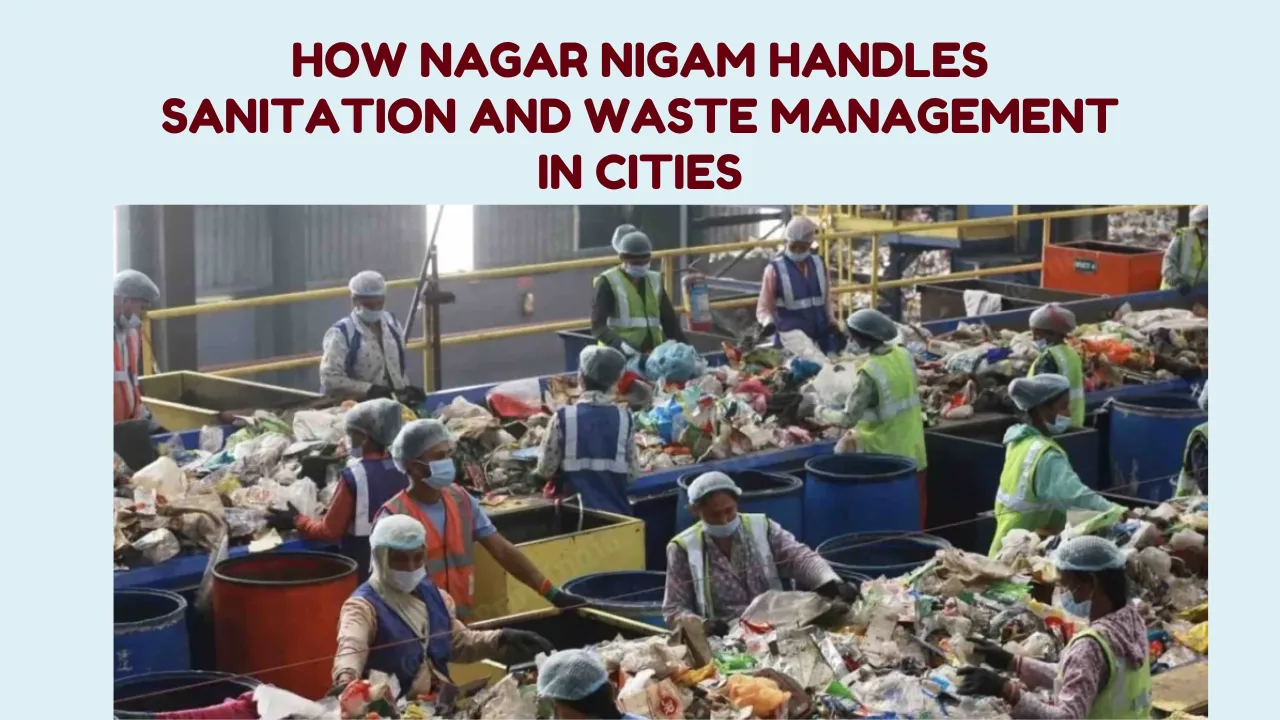How Nagar Nigam Handles Sanitation and Waste Management in Cities: How Nagar Nigam handles sanitation and waste management in cities is a crucial topic in today’s urban development discussions. As cities grow rapidly, managing cleanliness and hygiene becomes more complex and essential to public health and quality of life.
This article explores the roles and responsibilities of Nagar Nigams (municipal corporations) in keeping our cities clean. From daily garbage collection and waste segregation to modern recycling methods and citizen participation, we’ll cover how these civic bodies maintain sanitation standards and deal with urban waste efficiently.
Daily Waste Collection and Cleaning
One of the primary tasks in how Nagar Nigam handles sanitation and waste management in cities is regular waste collection. Most Nagar Nigams deploy trucks, carts, and garbage bins across wards to collect solid waste from homes, markets, and public places. Sanitation workers play a vital role in this process, starting their day early to sweep streets and clear garbage piles.
To improve efficiency, many cities now use GPS-enabled garbage trucks and tracking apps. This helps monitor the movement of waste collection vehicles and ensures timely service.
Waste Segregation and Disposal
Nagar Nigams are promoting the segregation of waste at the source. Residents are encouraged to separate wet waste (like food leftovers) and dry waste (like plastics and paper). This segregation is important because it makes recycling easier and reduces the load on landfills.
Collected waste is taken to different processing centers:
- Wet waste is sent to composting plants.
- Dry waste is sent for recycling.
- Non-recyclable waste is sent to landfills or waste-to-energy plants.
Proper segregation reduces environmental pollution and helps in better resource recovery.
Role of Waste Management Systems
Modern waste management systems are key to understanding how Nagar Nigam handles sanitation and waste management in cities. These systems include:
- Material Recovery Facilities (MRFs) for sorting and recycling dry waste.
- Composting Units for turning wet waste into organic manure.
- Incineration Plants for burning hazardous or non-recyclable waste.
- Sanitary Landfills for the final disposal of inert waste.
Some cities have even adopted smart dustbins and digital monitoring systems to track bin levels and cleaning schedules.
Public Toilets and Sanitation Infrastructure
In addition to waste, Nagar Nigams are responsible for building and maintaining public toilets. These facilities are crucial, especially in slum areas and public spaces. Clean and safe toilets help prevent diseases and maintain hygiene standards in cities.
Municipal corporations also conduct regular cleaning of drains, sewers, and stormwater lines to prevent blockages and waterlogging.
Two Important Initiatives Taken by Nagar Nigams
1. Swachh Bharat Mission Implementation:
Under this national program, Nagar Nigams promote awareness campaigns, set cleanliness targets, and rank cities based on cleanliness through surveys like Swachh Survekshan.
2. Door-to-Door Awareness Programs:
Many municipal bodies conduct door-to-door campaigns to educate people on waste segregation, composting, and responsible disposal. These programs increase public involvement and make the system more effective.
Handling Biomedical and Hazardous Waste
Apart from household waste, Nagar Nigams also oversee the safe disposal of biomedical and hazardous waste. Hospitals, clinics, and industries must follow strict rules for separating and disposing of these wastes. Nagar Nigams coordinate with specialized agencies to handle and process such materials safely.
This is essential to prevent health risks and environmental damage.
Involving Citizens in Clean City Efforts
The success of any sanitation and waste management system depends on active citizen participation. Nagar Nigams use several methods to involve the public:
- Community cleanliness drives
- Waste segregation contests
- Feedback systems and mobile apps
- Collaboration with local NGOs and RWAs (Resident Welfare Associations)
By involving the community, municipal corporations create a sense of responsibility among citizens, which leads to cleaner neighborhoods.
Challenges Faced by Nagar Nigams
Even though efforts are being made, there are still many challenges:
- Shortage of trained sanitation staff
- Limited budget for advanced infrastructure
- Low participation from some areas
- Illegal dumping of waste
- Delays in processing waste due to poor logistics
Solving these issues requires better planning, more investment, and stronger community cooperation.
FAQs
1. What is the main role of Nagar Nigam in waste management?
Nagar Nigams are responsible for collecting, segregating, transporting, processing, and safely disposing of city waste.
2. How do Nagar Nigams promote waste segregation?
They use awareness campaigns, fines, and door-to-door education to teach people about separating wet and dry waste.
3. Are public toilets maintained by Nagar Nigam?
Yes, Nagar Nigams build and maintain public toilets in markets, parks, and urban slums to ensure public hygiene.
4. Can citizens report waste-related issues?
Yes, many Nagar Nigams have helplines, apps, and online portals for citizens to report complaints or request services.
5. What happens to the collected garbage?
It is sent to composting plants, recycling centers, or landfills based on its type and usability.
Final Thought
Understanding how Nagar Nigam handles sanitation and waste management in cities gives us a deeper appreciation of the work done behind the scenes to keep urban areas clean. But sanitation is not just the government’s job—it’s everyone’s responsibility. Let’s support these efforts by following cleanliness practices and being responsible citizens.
Was this article helpful? Share your thoughts in the comments and don’t forget to check out our clean city tips or other urban development guides!







